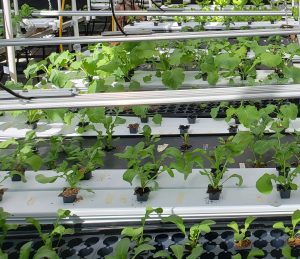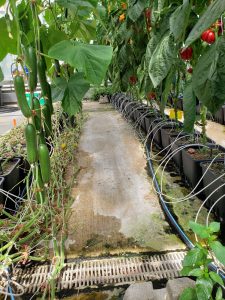Last month I shared some basic info on the major techniques for growing plants without soil, namely hydroponics, aquaponics, and aeroponics. With such interest in these topics, I thought it would be good to dive a little further into the technologies used. I’ll provide a bit of basic information about each type of system used for production and provide some resources for further technical reading if you’re interested in learning more. For some simple diagrams of the systems, check out this link (we don’t know if we can “borrow” the images, so we didn’t copy them over).
DEEP WATER
“Deep” water may be a bit of a misnomer, as it usually brings to mind thoughts of mysterious sea creatures living in the dark depths of the ocean. Technically, the “deep” water can be just a few inches, as it is deep in reference to other methods. This is perhaps the simplest and least expensive of the systems and can be a great entry point for beginners.
For deep water culture, the nutrient solution is held in a large container with some sort of floating support holding the plants. The container is at least a few inches deep and holds a relatively high volume of water. There are some containers that are designed for deep water hydroponics, but repurposed containers will work as long as they are food safe (meaning that they do not leach or break down). Large plastic totes or even plastic buckets can be used. As for supporting structures for plants, Styrofoam is the most common. There are cell trays made of Styrofoam that are commonly used in production of small crops (or for growing transplants, which is a common use of this technique). Foam boards with holes to hold pots can also be used. Back when I was in grad school we developed hydroponic systems in my plant propagation class using foam insulation boards floating in large plastic totes.
One thing that you have to keep in mind for deep water culture is the need to incorporate oxygen into the system. We often talk about the issue of overwatering houseplants and how it can damage roots due to hypoxic, or low oxygen, situations. Imagine how roots growing only in water would create situations for poor root and plant growth. In all the other systems water flow helps incorporate oxygen into the water. In deep water, there is no moving water and therefore no air incorporation. The most common tool used for this, especially for small systems, is an aquarium air pump and air stones that help create bubbles in the system.
One benefit of this system is that it has a low level of risk when it comes to system failure. There are few moving parts to break down and loss of electric doesn’t result in roots drying out due to loss of water flow.
EBB & FLOW
These systems, also called flood and drain systems, are one step of complexity above the deep water systems by introducing water flow. Plants can either float as in deep water culture or be held in media that fills the container. While many containers can be used, the most common are longer channels that promote water flow from one end to the other. This system also introduces a reservoir of some sort that holds excess nutrient solution and a pump to deliver it to the container. The level of water in the container is controlled by a raised drain pipe where solution exits the system back to the reservoir.
The DIY system I build using gutter with the Rwandan students (mentioned in the first installment on hydroponics) is ebb and flow. The drain from the gutters is a few inches high within the channel, so the water raises those few inches before it drains out. Some producers use long channels the width of those floating cell trays to grow plants in a relay fashion, planting them on one end and move them along as new rafts are added until they are harvested on the other end.
This system is common not only in hydroponics, but aquaponics as well. Instead of a nutrient solution reservoir, the water from the tank(s) holding the aquatic stock (commonly fish, but could also be crustaceans like shrimp) is pumped into the plant channels and flows back into the system. Systems may be based on continuous flow into and out of the system, but most commonly a timer is used to have multiple periods of flow and rest mainly as a means to reduce power usage.
NUTRIENT FILM TECHNIQUE (NFT)
 This system evolved one more step above ebb and flow by limiting the volume of water used in the system. Here, water is pumped from the solution reservoir to shallow channels where plants are held in pots or blocks of inert media such as rockwool. Roots are not submerged in water, but instead grow within a thin film of solution that flows almost continuously through the system. These channels have a slight slope where the end with the drain is a little bit lower than the end where the water enters. The slope can be adjusted slightly to affect the speed of the water through the system.
This system evolved one more step above ebb and flow by limiting the volume of water used in the system. Here, water is pumped from the solution reservoir to shallow channels where plants are held in pots or blocks of inert media such as rockwool. Roots are not submerged in water, but instead grow within a thin film of solution that flows almost continuously through the system. These channels have a slight slope where the end with the drain is a little bit lower than the end where the water enters. The slope can be adjusted slightly to affect the speed of the water through the system.
This system is becoming common in production of leafy greens and herbs because it uses a much smaller volume of water. But that small volume of water also presents a risk. If there is a power failure or a clog in the tubing that delivers water to the system the roots can very quickly dry out and crops die, especially in situations of high heat and light.
DRIP SYSTEMS

Perhaps one of the most commonly used systems across the world due to their simplicity, drip systems could be compared to a drip irrigation system used in the field. Drip emitters are used to supply nutrient solution to plants in containers containing an inert media such as peat, coir, perlite, or grow stones. The containers can be pots, buckets, or bags/blocks of the media and are most commonly placed on the floor of the greenhouse or growing location with gutters to collect the solution that flows through the containers. A common method is using long, narrow bags filled with coir or other media referred to as the slab method. Another common method, called the Dutch bucket method, uses buckets with drain holes in the bottom, commonly placed on a greenhouse floor. Water trickles down through the media and roots and leaves the system through the bottom of the container.
Systems vary in the collection of the used solution. Some may collect the solution that flows into the gutter and collect it in a reservoir to be reused, however some systems may allow the solution to flow out as waste. These differences depend on the needs of the producer, available resources, and local regulations.
One of the comments that we got on my first article was about people growing container plants could technically consider it a form of hydroponics. That might be a bit of a stretch, but you could technically consider growing container plants in soil-less media as drip or flow through hydroponics if you provide all of the nutrients through soluble fertilizers in the water.
WICK SYSTEMS
Typically used for small scale production, wick systems are one of the simple ways to grow plants without soil in terms of technology. In this system, a passive wick uptakes nutrient solution from a reservoir and pulls it into the media (usually absorbent itself). This wick could be a true wick, like a string made of absorbent material that inserts into an individual pot or it could be a mat made of absorbent material that pots or trays sit atop.
I’ve seen this commonly used perhaps not strictly in hydroponics, but for watering individual plants like African violets where yarn or twine is inserted into a drain hole in the pot and sits in water. Technically this could be hydroponics if the media doesn’t contribute nutrients to the plant and they are all contained in the water instead.
KRATKY METHOD
This is probably the simplest of the methods and is used primarily by small scale producers and home growers. It is similar to the deep water method in that there is no flowing water, but it is even simpler because there isn’t even an air bubbler. In this method, plants are grown in large containers or buckets and the structure that supports them is fixed to the top of the container rather than floating. As the growing solution is used up, the level of solution in the container decreases. This creates a zone where the roots are exposed to air, providing the oxygen that the roots need. The solution is kept at a level where at least the bottom portion of the roots are submerged in the nutrient solution.
AEROPONICS
Probably the most complex or technical system, aeroponics supplies water and nutrients to plants through a mist or aerosol emitted through pressurized nozzles. The roots hang in a chamber without media and are misted every few minutes with nutrient solution. The excess solution drops to the bottom of the chamber and is reused. This system uses very small amounts of water, which can be beneficial for growing in dry areas but also creates a potential risk if the system or power fails. Just like the NFT system, any prolonged period with out water will quickly result in plant damage or loss. Beside power loss, this systems is also prone to clogged emitters, since the pressurized nozzles rely on very tiny openings to pressurized the solution.
Keep in mind that several systems that are sold for home or small scale production that are labeled as aeroponic, such as AeroGarden and Tower Gardens, don’t technically use aeroponics to grow since the solution isn’t applied as a mist or aerosol. I would say they operate more like a vertical NFT system where water flows over the roots as it travels down the chamber.
RESOURCES
Hydroponic Greenhouse Production Resources – UMass Extension
Introduction to Hydroponics – Johnny’s Seed
All You Need to Know to Choose a Hydroponic System – Upstart Farmers
How to Start Growing with the Kratky Method – Upstart Farmers

For a great place to talk and share with people who care about their garden and finding the right fit this site is unbelievable concerning gardening and they offer great advice. Do you have a topic about dethatching?
Not yet – but it’s a good idea!